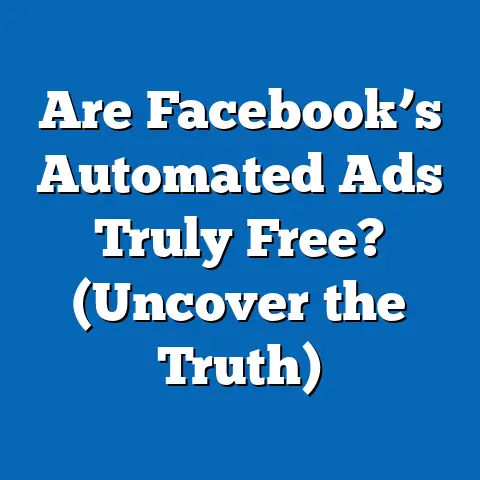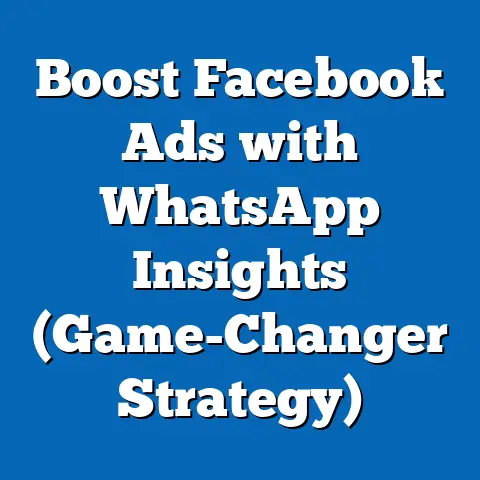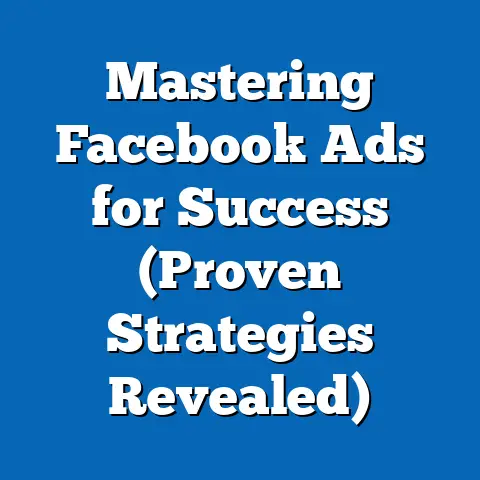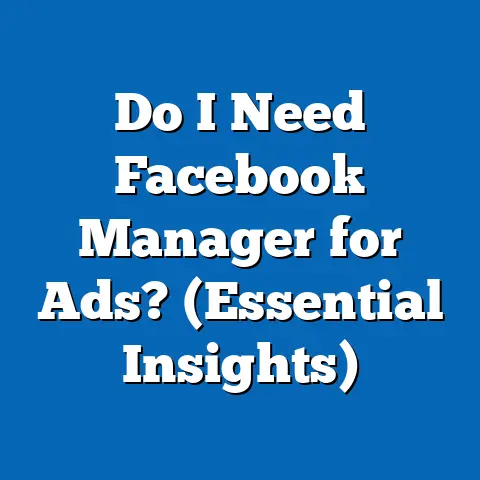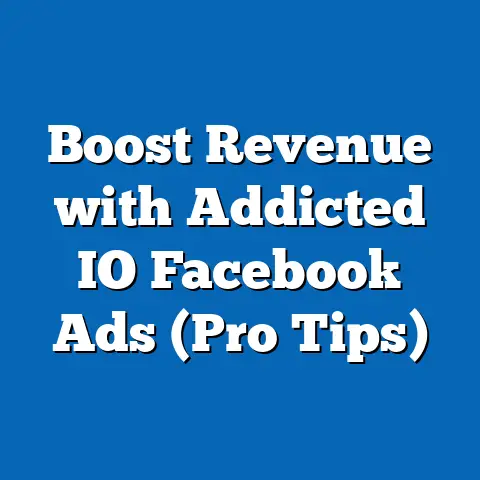Maximize Facebook Ad Spending Limit (Strategic Insights)
I remember the first time I dipped my toes into the world of Facebook ads. It was for a small local bakery I was helping out. We had beautiful photos of our pastries, a catchy slogan, and a burning desire to reach every sweet tooth in town. I meticulously set up the campaign, targeting folks within a 5-mile radius, and then… I set a daily budget of $5. I thought, “Hey, it’s something, right?” Well, it was something alright – a learning experience. I quickly realized that understanding and strategically managing ad spending limits is crucial. It’s not just about setting a number; it’s about knowing how to get the most bang for your buck, and that’s exactly what I’m going to unpack for you today.
Understanding Facebook Ad Spending Limits
Facebook ad spending limits are essentially controls you set to manage how much money you spend on your advertising campaigns. They’re like the brakes on a car – necessary to keep you from careening out of control and crashing your budget. Facebook provides these limits to help advertisers, especially those new to the platform, prevent unexpected costs and maintain control over their marketing investment.
There are two primary types of spending limits within Facebook Ads Manager:
- Daily Budget: This is the average amount you’re willing to spend on a campaign each day. Facebook’s algorithm may spend slightly more or less on any given day, but over the course of a week, it will aim to keep the average daily spend near your specified limit.
- Lifetime Budget: This is the total amount you’re willing to spend on a campaign over its entire duration. Once the lifetime budget is reached, the campaign will stop running.
These limits directly impact your campaign performance. Too low, and you might not reach enough of your target audience to achieve your desired results. Too high, and you risk blowing through your budget without seeing a return. It’s a delicate balance.
The Importance of Setting a Realistic Spending Limit
Setting a realistic spending limit is more than just a financial exercise; it’s a strategic imperative. I’ve seen countless campaigns fail because of poorly considered budgets. Imagine launching a campaign with a tiny budget targeting a vast audience. Your ads will likely be shown to a small, random subset of that audience, leading to minimal impact and a low return on investment.
Unrealistic budgets can hinder campaign effectiveness in several ways:
- Limited Reach: A low budget means your ads won’t be shown to as many people.
- Poor Frequency: Your target audience might not see your ads enough times to remember your brand or take action.
- Missed Opportunities: You might miss out on valuable conversions due to insufficient budget to reach potential customers at the right time.
Aligning your spending limits with your overall marketing goals and budget constraints is crucial. Ask yourself:
- What are you trying to achieve with this campaign? (Brand awareness, lead generation, sales, etc.)
- What is the value of each conversion?
- How much are you willing to spend to acquire a customer?
By answering these questions, you can determine a realistic cost per acquisition (CPA) target and set your spending limits accordingly. Remember, it’s better to start small, test, and scale than to throw money at a campaign with no clear strategy.
Strategies to Maximize Your Spending Limits
Now, let’s get into the meat of the matter: how to squeeze every last drop of value out of your Facebook ad budget. Here are some tried-and-true strategies I’ve used over the years:
Audience Targeting: Precision is Key
One of the biggest mistakes I see advertisers make is casting too wide a net. They target broad demographics with little regard for specific interests or behaviors. This is a surefire way to waste money.
Effective audience targeting involves:
- Defining Your Ideal Customer: Create a detailed profile of your ideal customer, including their demographics, interests, behaviors, and pain points.
- Leveraging Facebook’s Targeting Options: Use Facebook’s detailed targeting options to reach people who are most likely to be interested in your products or services. This includes interest-based targeting, behavior-based targeting, and demographic targeting.
- Creating Custom Audiences: Upload your customer lists to create custom audiences of existing customers or website visitors. This allows you to retarget people who have already shown interest in your brand.
- Building Lookalike Audiences: Use your custom audiences as a seed to create lookalike audiences of people who share similar characteristics to your best customers. This is a powerful way to expand your reach while maintaining relevance.
I once worked with a clothing boutique that was struggling to get traction with their Facebook ads. They were targeting women aged 25-55 in a large metropolitan area. We refined their targeting by focusing on women who were interested in specific fashion brands, followed relevant influencers, and had recently engaged with similar businesses online. The results were dramatic. Their click-through rate (CTR) increased by 3x, and their conversion rate doubled.
Ad Creative Optimization: Make Every Impression Count
Your ad creative is what grabs people’s attention and compels them to take action. It’s the storefront of your online business, and it needs to be visually appealing, informative, and persuasive.
Here are some tips for optimizing your ad creative:
- Use High-Quality Visuals: Invest in professional photos or videos that showcase your products or services in the best possible light.
- Write Compelling Copy: Craft clear, concise, and persuasive copy that highlights the benefits of your offer and speaks directly to your target audience.
- Include a Strong Call to Action: Tell people exactly what you want them to do (e.g., “Shop Now,” “Learn More,” “Sign Up”).
- Use Different Ad Formats: Experiment with different ad formats, such as image ads, video ads, carousel ads, and collection ads, to see what resonates best with your audience.
- Keep it Relevant: Ensure your ad creative is relevant to your target audience and the context in which it’s being shown.
I remember working on a campaign for a local brewery. We initially used generic images of beer glasses, but the ads weren’t performing well. We decided to create a short video showcasing the brewery’s unique atmosphere and the passion of its brewers. The video resonated with the local community, and the campaign saw a significant boost in engagement and sales.
A/B Testing: The Scientific Approach to Advertising
A/B testing, also known as split testing, is the process of comparing two versions of an ad to see which one performs better. This is a crucial step in optimizing your ad campaigns and maximizing your return on investment.
Here’s how to conduct effective A/B tests:
- Identify What to Test: Choose one element of your ad to test at a time (e.g., headline, image, call to action).
- Create Two Versions: Create two versions of your ad with slight variations in the element you’re testing.
- Run the Test: Run the test for a sufficient period of time to gather statistically significant data.
- Analyze the Results: Analyze the results to see which version performed better.
- Implement the Winner: Implement the winning version of the ad and continue testing other elements to further optimize your campaign.
I once ran an A/B test on a campaign for an e-commerce store selling handmade jewelry. We tested two different headlines: “Unique Handmade Jewelry” vs. “Shop Our Artisan Jewelry Collection.” The second headline, “Shop Our Artisan Jewelry Collection,” performed significantly better, resulting in a 20% increase in click-through rate.
Utilizing Retargeting: Converting Warm Leads
Retargeting is the practice of showing ads to people who have previously interacted with your brand, such as website visitors, app users, or social media followers. This is a highly effective way to convert warm leads into customers.
Here’s how to leverage retargeting:
- Install the Facebook Pixel: Install the Facebook Pixel on your website to track visitor behavior.
- Create Custom Audiences: Create custom audiences of website visitors, app users, or social media followers.
- Show Relevant Ads: Show relevant ads to these audiences based on their previous interactions with your brand. For example, if someone viewed a specific product on your website, you can show them an ad for that product.
- Offer Incentives: Offer incentives, such as discounts or free shipping, to encourage people to complete a purchase.
I worked with a travel agency that used retargeting to target people who had visited their website and searched for flights to specific destinations. They showed these people ads featuring special deals on those flights, resulting in a significant increase in bookings.
Monitoring Metrics: Keep Your Finger on the Pulse
Monitoring your key performance indicators (KPIs) is essential for understanding how your campaigns are performing and making data-driven decisions.
Here are some important metrics to track:
- Reach: The number of unique people who saw your ads.
- Impressions: The number of times your ads were shown.
- Click-Through Rate (CTR): The percentage of people who clicked on your ads.
- Conversion Rate: The percentage of people who took a desired action after clicking on your ads (e.g., making a purchase, filling out a form).
- Cost Per Acquisition (CPA): The cost of acquiring a customer.
- Return on Ad Spend (ROAS): The revenue generated for every dollar spent on advertising.
Regularly review these metrics and adjust your ad spend accordingly. If a campaign is performing well, consider increasing the budget. If a campaign is underperforming, try optimizing your targeting, creative, or bidding strategy.
Case Studies and Real-Life Examples
Let’s look at some real-world examples of businesses that have successfully maximized their Facebook ad spending limits:
- Example 1: E-commerce Store A small e-commerce store selling handmade soaps used precise audience targeting and compelling ad creative to achieve a 5x return on ad spend. They focused on targeting people interested in natural skincare and featured high-quality images of their products with clear calls to action.
- Example 2: Local Restaurant A local restaurant used retargeting to target people who had visited their website and viewed their menu. They showed these people ads featuring mouthwatering photos of their dishes and special offers, resulting in a significant increase in reservations.
- Example 3: SaaS Company A SaaS company used A/B testing to optimize their lead generation ads. They tested different headlines, images, and calls to action, resulting in a 30% increase in lead conversion rate.
These examples demonstrate that by implementing the strategies I’ve discussed, businesses of all sizes can maximize their Facebook ad spending limits and achieve their marketing goals.
The Role of Facebook’s Algorithm in Spending Limits
Facebook’s algorithm plays a significant role in how your ad spend is utilized. It determines which ads are shown to which users, and it optimizes for the goals you set (e.g., reach, impressions, conversions).
Understanding how the algorithm works is crucial for effectively managing your ad spend. Here are some key points to keep in mind:
- Learning Phase: When you launch a new campaign or make significant changes, the algorithm enters a learning phase where it tries to identify the best audience and ad creative for your goals. During this phase, performance may be volatile.
- Bid Strategy: Your bid strategy (e.g., lowest cost, target cost, cost cap) influences how the algorithm bids on ad auctions. Choosing the right bid strategy is essential for maximizing your return on investment.
- Ad Relevance: The algorithm prioritizes ads that are relevant to the user. This is why it’s so important to target the right audience and create compelling ad creative.
Staying up-to-date with algorithm changes and updates is also crucial. Facebook frequently updates its algorithm, and these changes can impact your campaign performance. Follow industry blogs and publications to stay informed and adapt your strategies accordingly.
Conclusion
Maximizing your Facebook ad spending limit is not about simply throwing money at the platform. It’s about strategic thinking, precise targeting, compelling creative, and data-driven decision-making. By implementing the strategies I’ve outlined in this article, you can get the most out of your ad spend and achieve your marketing goals.
Remember, Facebook advertising is an ever-evolving landscape. The key to success is to stay curious, keep testing, and never stop learning. The future of Facebook advertising will undoubtedly bring new challenges and opportunities, and those who are willing to adapt and innovate will be the ones who thrive. So, keep experimenting, keep analyzing, and keep pushing the boundaries of what’s possible. Your next successful campaign is just around the corner!

